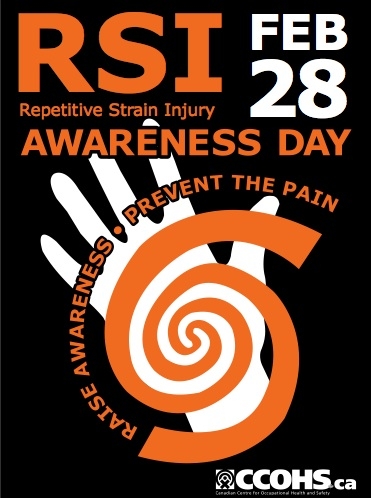
Articles
Fabrication
Raising awareness of repetitive strain injuries
February 20, 2014 By Canadian Centre for Occupational Health and Safety

Feb. 20, 2014 – Each year, the last day of February is reserved for International Strain Injury (RSI) Awareness Day, a day dedicated to RSI education and prevention, according to the Canadian Centre for Occupational Health and Safety. February 28 will mark the 15th Annual RSI Awareness Day. Repetitive strain injuries, also known as work-related musculoskeletal disorders (WMSD), is an umbrella term to describe a family of painful disorders affecting tendons, muscles, nerves and joints in the neck, upper and lower back, chest, shoulders, arms and hands. These disorders can be caused by work activities that are frequent and repetitive, or activities with awkward postures.
Feb. 20, 2014 – Each year, the last day of February is reserved for International Strain Injury (RSI) Awareness Day, a day dedicated to RSI education and prevention, according to the Canadian Centre for Occupational Health and Safety. February 28 will mark the 15th Annual RSI Awareness Day. Repetitive strain injuries, also known as work-related musculoskeletal disorders (WMSD), is an umbrella term to describe a family of painful disorders affecting tendons, muscles, nerves and joints in the neck, upper and lower back, chest, shoulders, arms and hands. These disorders can be caused by work activities that are frequent and repetitive, or activities with awkward postures.
WMSDs can be caused by work activities that are frequent and repetitive, or activities with awkward postures, including fixed or constrained body positions; continual repetition of movements; force concentrated on small parts of the body, such as the hand or wrist or a pace of work that does not allow enough rest between movements. Heat, cold and vibration may also contribute to the development of WMSDs. These disorders are generally caused by a combination of these factors – rather than one individual factor.
A fundamental principle of occupational health and safety is that hazards are best eliminated at the source. In the case of WMSDs, the prime source of hazard is the repetitiveness of work. Prevention must aim at eliminating the repetitiveness of the work by proper job design. Where this is not possible, preventive strategies such as good workplace layout, tool and equipment design, and proper work practices should be considered. It is important to recognize these disorders early because medical treatments become less effective the longer these injuries go on.
Preventive and control measures, in order to be truly effective, require significant involvement on the part of the workers, their representatives, and management to improve occupational health and safety.
For a number of free resources for the prevention of WMSDs, including fact sheets, podcasts, webinars and e-courses, visit the Canadian Centre for Occupational Health and Safety website.
For more information
ccohs.ca
Print this page
Leave a Reply